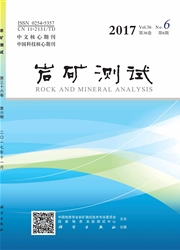

 中文摘要:
中文摘要:
微区Sr同位素体系相对于传统全岩Sr同位素研究,可以揭示样品自身存在的不均一性,更好地反映样品经历的地质过程,已被广泛应用于各种地质研究领域,如研究壳幔相互作用、岩浆起源和演化,岩浆体系开放性研究,沉积盆地物源示踪及气候环境研究。准确测定Rb-Sr同位素比值是应用该同位素体系的前提。微钻取样-热电离质谱/多接收电感耦合等离子体质谱(TIMS/MC-ICPMS)和激光剥蚀多接收电感耦合等离子体质谱(LA-MC-ICPMS)作为分析地质样品微区Sr同位素组成的有效手段,已经得到了较为广泛的应用。两种技术在样品制备、干扰校正和质谱测试等方面各具优势和不足。微钻取样-TIMS/MC-ICPMS的最大优势是可获得高精度的Sr同位素数据(外精度优于10010-6,2SD);但由于需要进行化学处理,流程繁琐耗时(约10天),实验周期较长,同时需要严格控制化学流程空白,且取样直径(200~2000 μm)和取样深度(100~2000 μm)较大,空间分辨率较低,但是该方法可以对高Rb样品(如钾长石)进行有效分析。LA-MC-ICPMS的最大优势是样品制备简单,数小时即可完成,且分析效率高,根据样品Sr含量的大小激光束斑直径多在60~300 μm之间变化, 其空间分辨率较前一种方法高,可在短时间内对大量样品进行分析。但由于不能进行化学分离,分析过程中存在多种干扰(如Rb、Ca、Kr和REEs等),影响了测试的精度(约20010-6,2SD)和准确度(约15010-6)。该方法目前只能对高Sr低Rb的样品(如斜长石、磷灰石等)进行有效分析,而对于干扰元素含量较高的样品目前无法应用。本文认为,对于微钻取样法,应将改进化学流程作为重点研究方向,提高化学处理效率,同时改善微钻取样法的取样技术,减小取样直径和深度以提高空间分辨率;对于激光剥蚀法,重点突破Kr?
 英文摘要:
英文摘要:
Compared to the traditional strontium isotope analytical method, a micro-sample strontium isotope system study can reveal the heterogeneity of analyzed samples and is widely used in various fields of geology, such as crust-mantle interaction, genesis and evolution of magmas, open magma systems, tracing provenance of sedimentary basin and climate research. Accurate measurement of Rb-Sr isotopic ratios is the premise to apply Sr isotope in these research fields. Two detailed and widely used analysis methods for micro-sample Sr isotope measurement are microdrilling-TIMS/MC-ICPMS and LA-MC-ICPMS. These two methods have different advantages and disadvantages in sample preparation, interference correction and measurement in mass spectrometry. The greatest advantage of microdrilling-TIMS/MC-ICPMS is that this technique can acquire high quality data (external precision is better than 10010-6, 2SD). However the tedious chemical separation is very time-consuming (about 10 days) and the chemical procedure blank must be critical to low level. The large sampling depth (100-2000 μm) and diameter (200-2000 μm) reduce the spatial resolution. However, with chemical separation this method can effectively measure samples with high Rb content. Simple sample preparation and fast analysis are the most outstanding advantages of LA-MC-ICPMS which can analyze lots of samples in a much shorter time than that of microdrilling-TIMS/MC-ICPMS. The laser spot size is mainly from 60 to 300 μm. Based on Sr contents in samples, the method of LA-MC-ICPMS improved spatial resolution, compared to microdrilling-TIMS/MC-ICPMS technique. However, without chemical separation, many kinds of interferences (e.g. Rb, Ca, Kr and REEs) hinder this technique to obtain high quality data (external precision is about 20010-6, 2SD and accuracy is about 15010-6). LA-MC-ICPMS is only suitable for high Sr and low Rb samples, instead of samples with high content of interferences. Further studies are required for the microdrilling-TIMS/MC-ICP
 同期刊论文项目
同期刊论文项目
 同项目期刊论文
同项目期刊论文
 期刊信息
期刊信息
